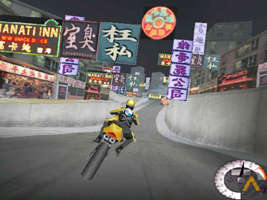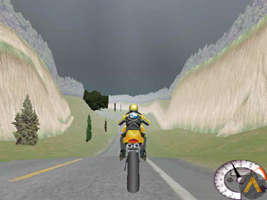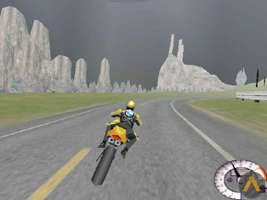|
Test Drive Cycles
Nb! (some material are used from other sites) No advertisement can be put up to this site. This is applicable by law. |
||||
|
|
PUBLISHER: Infogrames North America
Test Drive Cycles promises to be an interesting mix of arcade and simulation elements. Producer Jack points out that, "No game had yet delivered the action of arcade-style control with the real-world performance of licensed bikes, nor had any game really delivered the experience of street-bike riding." Using the real torque curves, acceleration, top speed, handling characteristics, weight, and braking ability to define the in-game bikes, the motorcycles here perform very closely to their real-world counterparts. In Test Drive Cycles, the arcade-style gameplay affects the control and handling model, track designs, and types of obstacles encountered. For example, obstacles that would cause bikes in real life to crash will simply cause them to become unsettled in the game. Since the tracks feature traffic and in some cases police, quick reflexes will definitely be needed to weave through objects in the way and avoid being apprehended. This combination of easy control with real-world physics of motion is a tough one to imagine, and it will be really interesting to see how Infogrames North America implements it. Test Drive Cycles (Cont.) Included here are more than 30 licensed motorcycles with multiple upgrade packages and color schemes. Players can choose from a variety of bikes including the Harley-DavidsonVR1000 and the Harley-Davidson Road King. Each offers its own unique handling characteristics and riding style. The designers took great care to ensure the accuracy of the bike models with respect to their real-world counterparts. On average there are about 500 polygons per bike, with another 300 to 400 polygons per rider. John Jack's favorite element of the game is the Harley-Davidson FatBoy, the motorbike that Arnold Schwarzenegger rode in Terminator 2. With 12 tracks from locations around the world, Test Drive Cycles includes the bustling city of Washington D.C., the tropical island of Bali, the deserts of Utah, and the historic site of Mount Rushmore in South Dakota, as well as Amsterdam, Hong Kong, Switzerland, and the French Riviera. The track designers have spent a lot of time obsessing over the quality level and detail of the tracks, especially when it comes to lighting. By using 3D Studio Max as the track authoring system, they have managed to use every trick to make these tracks be as visually stunning as possible. You can choose from three game modes, including quick race, championship or two-player split-screen. The tournaments within a championship allow you to earn prize money for upgrades and new bikes as well as to gain access to new tracks and tournaments. Smashing through roadblocks may open up new track paths and shortcuts. Test Drive Cycles will feature multi-player support via LAN or the Internet; since you have access only to bikes you own during multiplayer races, your previous successes in single player action will have a significant influence over your overall levels of success in multiplayer competition. Designed specifically for Test Drive Cycles, the game's new 3D engine incorporates realistic motorcycle physics into an arcade-racing environment. Although the developers borrowed no technology from previous Test Drive offerings, they did take advantage of the technology used to develop Slave Zero. John Jack explains that, "By starting with a complete art toolset, it gave us an excellent head start on the development process; whenever you develop new technology, the toolset is often the most frustrating part of the process, because you have an entire art and design team using the tools every day." The Surrender code is serving as the rendering API, providing great support for Glide, Direct3D, OpenGL, and a software renderer. Test Drive Cycles will sport scalability in terms of both color depth (16-bit and 32-bit) and screen resolutions. Each race features five artificially intelligent computer-controlled opponents, and each of these riders has access to the same bikes as you do. This means that if one of the AI riders is riding an upgraded version of the bike you are riding, its bike will perform better. Each of these AI riders has its ownpreferred race line, but can deviate from the line depending on your location, traffic congestion, and proximity to other riders. The artificially intelligent riders become progressively more challenging throughout the championships, and the top riders on the top bikes promise to be really tough to beat. This title is now about half done, with no pre-release version yet available, and most of what remains to be done is on the art and gameplay side. There are currently eight tracks in development, with four already complete. Almost all the modeling is done on the bikes and riders, including animation and texture maps. The major challenge remaining, as is usually the case, is tuning the gameplay: The designers are still trying to get the physics, the bike handling, and the artificial intelligence just the way they want it. I have a feeling the computer motorcycle racing world will be truly rocked when this offering comes out in early 2000. |
|||









